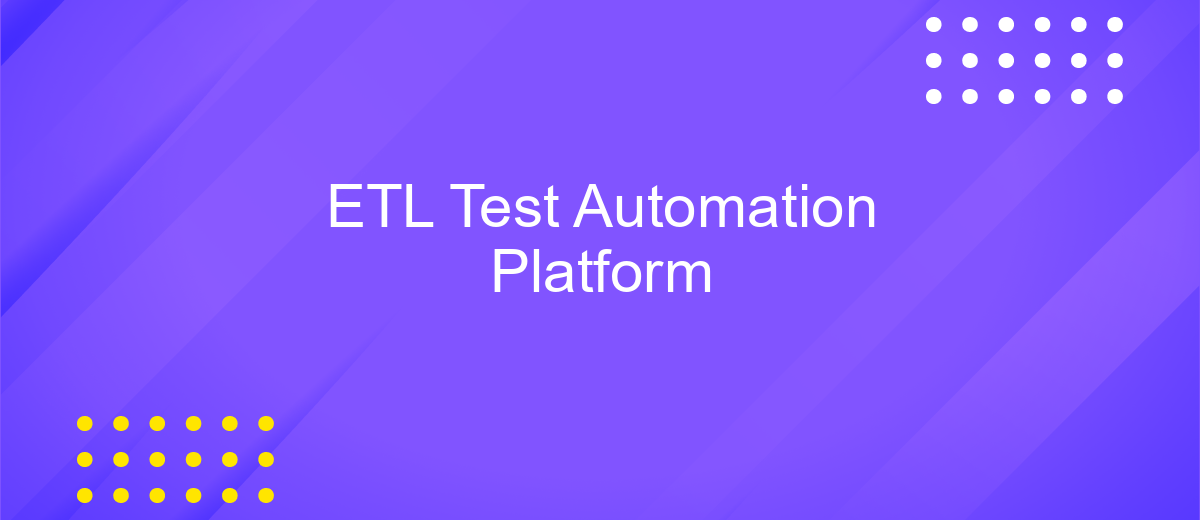ETL Test Automation Platform
In today's data-driven world, the efficiency and accuracy of ETL (Extract, Transform, Load) processes are crucial for businesses to make informed decisions. ETL Test Automation Platforms play a vital role in ensuring data integrity and reliability by automating the testing process. These platforms streamline workflows, reduce manual errors, and enhance the overall quality of data management, enabling organizations to harness the full potential of their data assets.
Introduction to ETL Test Automation and its Importance
ETL (Extract, Transform, Load) test automation is a crucial aspect of ensuring the integrity and reliability of data processing systems. As businesses increasingly rely on data-driven decision-making, the need for accurate and efficient data pipelines becomes paramount. Automated ETL testing helps in identifying discrepancies and errors in data transformation processes, thereby maintaining data quality and consistency.
- Reduces manual testing efforts and increases efficiency.
- Ensures data accuracy and integrity through consistent validation.
- Facilitates early detection of errors, minimizing downstream impacts.
- Supports continuous integration and delivery in data workflows.
- Enhances scalability by handling large volumes of data efficiently.
Incorporating ETL test automation into the data management lifecycle is essential for organizations aiming to leverage data as a strategic asset. It not only streamlines the testing process but also provides a robust framework for maintaining high data quality standards. By automating repetitive and time-consuming testing tasks, businesses can focus on strategic initiatives, ensuring that their data infrastructure remains agile and responsive to changing demands.
Key Features and Capabilities of an ETL Test Automation Platform

An ETL Test Automation Platform is designed to streamline the validation and verification of data extraction, transformation, and loading processes. Key features include robust data mapping capabilities, which ensure data consistency and accuracy across diverse data sources. Automated test script generation significantly reduces manual effort, enabling quicker identification of discrepancies and errors. With comprehensive logging and reporting tools, users gain insights into test results, facilitating efficient troubleshooting and continuous improvement of ETL processes.
Integration flexibility is another crucial capability, allowing seamless connectivity with various data sources and third-party tools. Platforms like ApiX-Drive enhance this by offering easy-to-configure integrations, enabling users to automate workflows without extensive coding. Additionally, these platforms support data quality checks and provide version control features, ensuring that any changes in the ETL processes are tracked and managed effectively. Together, these features empower organizations to maintain high data integrity and operational efficiency, ultimately supporting better decision-making and business outcomes.
Building an Effective ETL Test Automation Strategy

To build an effective ETL test automation strategy, it is crucial to understand the unique challenges and requirements of ETL processes. Start by identifying the key objectives of your testing strategy, such as ensuring data accuracy, completeness, and transformation integrity. This foundational understanding will guide the development of a comprehensive plan tailored to your specific ETL environment.
- Define clear testing objectives and success criteria to measure the effectiveness of your strategy.
- Select appropriate tools and technologies that align with your ETL architecture and testing goals.
- Develop reusable and maintainable test scripts to enhance efficiency and reduce redundancy.
- Implement continuous integration and delivery practices to ensure timely feedback and rapid iteration.
- Regularly review and update your testing strategy to adapt to evolving business needs and technological advancements.
By following these steps, you can establish a robust ETL test automation strategy that not only enhances testing efficiency but also ensures data quality and reliability. This strategic approach will empower your team to proactively identify and address potential issues, ultimately supporting the success of your data-driven initiatives.
Choosing the Right ETL Test Automation Platform

Selecting the appropriate ETL test automation platform is crucial for ensuring data integrity and system efficiency. With a multitude of options available, it's important to consider factors that align with your organization's specific needs and goals. A well-chosen platform can streamline processes, reduce manual effort, and enhance accuracy.
When evaluating potential platforms, consider the scalability and flexibility they offer. The ability to adapt to evolving data landscapes is essential. Additionally, integration capabilities with existing tools and technologies should be assessed to ensure seamless workflows. The platform's user interface and ease of use can significantly impact productivity, so prioritize solutions that offer intuitive design and comprehensive support.
- Scalability and flexibility to accommodate growing data volumes.
- Integration with existing tools and technologies.
- User-friendly interface and comprehensive support.
- Robust security features to protect sensitive data.
Ultimately, the right ETL test automation platform should empower your team to conduct thorough testing with minimal complexity. By focusing on these key aspects, you can ensure that the chosen solution not only meets current requirements but also supports future growth and innovation. A strategic selection can lead to improved data quality and operational efficiency.


Best Practices and Future Trends in ETL Test Automation
Implementing best practices in ETL test automation involves establishing a comprehensive strategy that includes data validation, integration testing, and performance monitoring. Automated testing frameworks should be robust and flexible to accommodate changes in data sources and transformations. Leveraging tools like ApiX-Drive can streamline integration processes by automating data flows between applications, reducing manual effort and potential errors. Continuous integration and delivery (CI/CD) pipelines are essential for ensuring that ETL processes are tested and deployed efficiently, minimizing downtime and maximizing data accuracy.
Looking to the future, ETL test automation is likely to be influenced by advancements in artificial intelligence and machine learning. These technologies can enhance anomaly detection and predictive analytics, making ETL processes more intelligent and adaptive. Additionally, the rise of cloud-based services and serverless architectures will further drive the need for automated testing solutions that can scale dynamically. As data environments become increasingly complex, the demand for sophisticated ETL test automation tools that offer real-time insights and seamless integration capabilities, like those provided by ApiX-Drive, will continue to grow.
FAQ
What is ETL Test Automation?
Why is ETL Test Automation important?
What are some common challenges in ETL Test Automation?
How can I integrate ETL Test Automation with existing systems?
What are the best practices for ETL Test Automation?
Time is the most valuable resource for business today. Almost half of it is wasted on routine tasks. Your employees are constantly forced to perform monotonous tasks that are difficult to classify as important and specialized. You can leave everything as it is by hiring additional employees, or you can automate most of the business processes using the ApiX-Drive online connector to get rid of unnecessary time and money expenses once and for all. The choice is yours!

